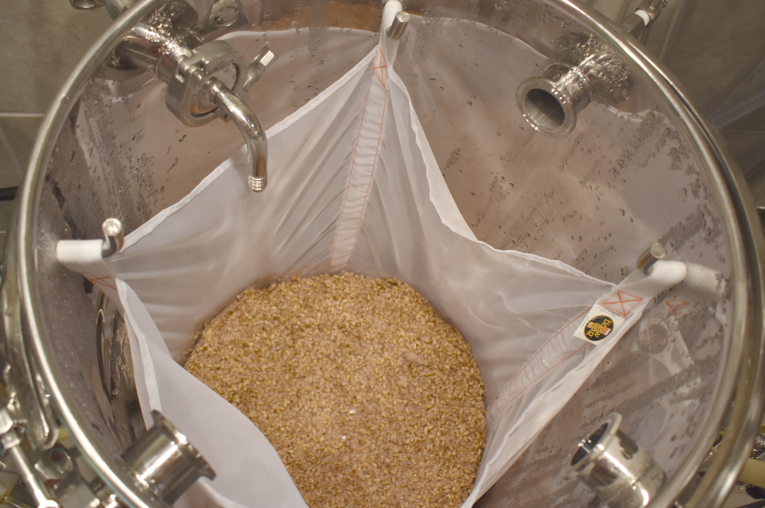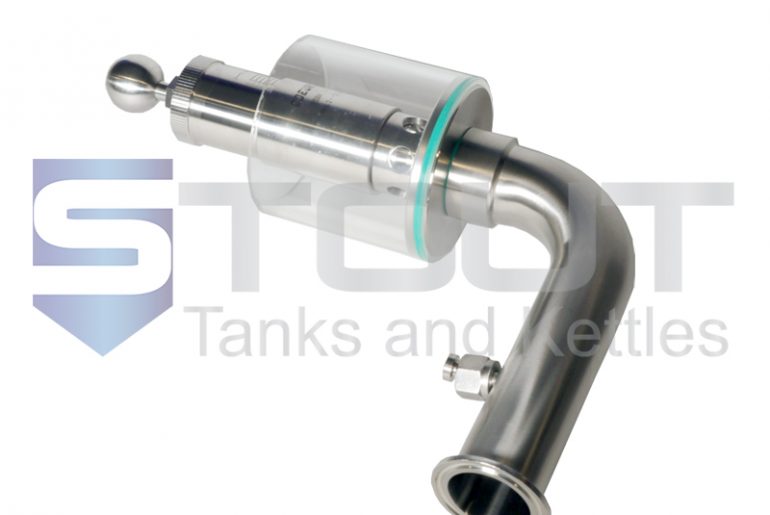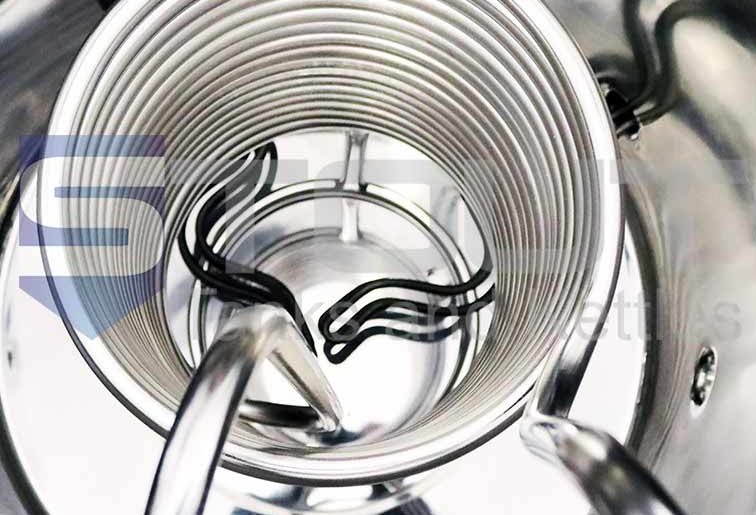(The following is a first-person narrative from Stout Tanks and Kettles’ owner John Watt.)
How I didn’t get enough oxygen into my wort!
The only way to get that beautiful lingering fresh grain flavor of authentic continental (German) lagers is to radically reduce the amount of dissolved oxygen in your brew. For my first brew on our new Low Ox system, I brewed a Munich lager, using high quality German malts. I wanted to preserve as much of that fresh grain flavor in the beer as possible. Malts naturally contain an enzyme in called Ascorbic Acid Oxidase (AAO), which is very sensitive to oxygen. Exposure to oxygen will destroy AAO, and with it that amazing flavor in the malt we are trying to preserve. At Stout, we’ve been engineering low oxygen home brew systems with the goal of having zero oxygen in the brew. I recently made my first batch of beer using the Stout Tanks and Kettles’ 20 Gallon low oxygen brewing system. Unfortunately for me, I did not introduce enough oxygen in this particular batch. Read on to find out how that is even possible

Prepare the Hot Liquor Tank.
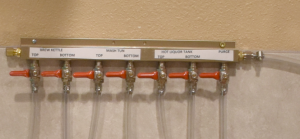
I prepped my hot liquor by preboiling the water and purging the head space with carbon dioxide. Boiling evaporates almost all of the dissolved oxygen that is in the hot liquor. Using the convenient gas fittings on the hot liquor tank, I purged the head space with CO2 to make sure no oxygen can re-dissolve into the hot liquor. I also bubbled CO2 up from the bottom gas inlet just to keep a positive pressure in the hot liquor tank so no oxygen could get back in. I have a gas manifold and check valves at the tank so I just open the appropriate gas valve when I want to purge the tank.
I cooled the hot liquor to 200F by running cold tap water through the HERMS coil (Heat Exchanged Recirculating Mash System) while simultaneously recirculating the hot liquor through the tangential inlet. We include tangential inlets on our hot liquor tanks to prevent temperature stratification. Hot water rises, so if you don’t circulate, you will end up with different temperature water at different levels in the tank, which will affect your mash temperatures.
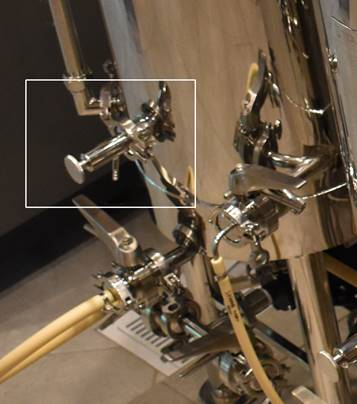
Because I wanted to make sure I could eliminate all the oxygen from the brew, I added enough Sodium Metabisulfite (SMB) to get 35 ppm in solution. SMB absorbs dissolved oxygen chemically (hint). I also added Brewtan B because I don’t have an RO system. In order to ensure that no oxygen was re-introduced into the hot liquor throughout the HLT preparation and mash, I periodically purged the head space and bubbled CO2 from the bottom gas inlet. Using the built-in sample valve on the HLT, I used sulfite test strips to confirm that I still had the amount of SMB I wanted in solution. Then I quickly cooled the HLT down to strike
Prepare the Mash Tun
To prepare for mashing, I installed a nylon mash bag in the mash tun using the 4 conveniently mounted hooks built right into the inside of the kettle. Then I placed my malt mill on top and purged oxygen from the tank with CO2 from the bottom inlet to displace as much oxygen as possible. Then I milled in my conditioned malt, while simultaneously flowing CO2 in through the bottom inlet in order to keep the O2 out. The mash bag allows me to run my vorlauf and HERMS at high flow rates without worrying about a stuck mash. My grains fell right into the mash bag.
After the grains were milled, I installed the vorlauf pipe, sparge arm, and strike water hose, which runs down to the bottom of the tun. After milling in, I quickly placed the lid on top and then installed the lid clamp, and continued purging the tank with CO2 for a short time. All 3 kettles have a VPRV (vacuum/pressure relief valve) and also a ¼” ball valve in the lid – I opened the ball valve whenever purging the kettle with CO2, which I did frequently throughout the mash.
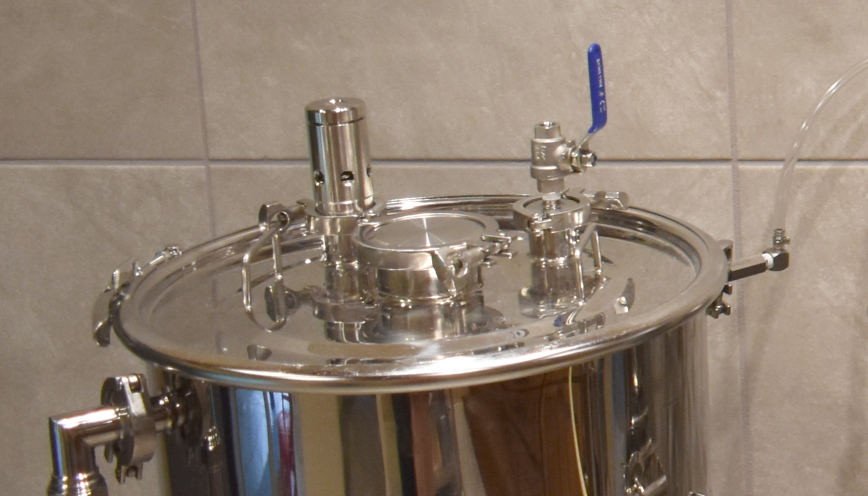
Mash-in:
Time to start brewing. Once the grains were milled, I made a point to mash in within 15 minutes to prevent oxidation of the grains – you are not guaranteed to get oxygen gas completely out of the milled grains when they are dry. I filled the mash tun from the bottom up, slowly, so I would not need to stir the grains too much. After the exact amount of water was added, I removed the 3” tri clamp cap, turned on the CO2 for a head space purge, and gave the mash a gentle stir. I don’t think the stir was actually necessary, but I’m glad I did it, because I noticed that there wasn’t enough water in the mash tun. Why would that be? Because of the mash bag – the grains did not push the mash bag out to the full diameter of the kettle, so the grains were higher than they normally would be (there was a gap between the mash bag and the edges of the mash tun). So, I had to add more water, and next time I will have to assume a higher water-to-grist ratio for my 5 gallon batches. After filling the tun with enough hot liquor, I replaced the 3” cap and purged the head space some more. Then, I used the convenient sample valve on the mash tun to grab a sample of the wort to test for SMB. The color on the test strip was the same as the HLT water, between 25 and 50 ppm (the scale is 0, 10, 25, 50, etc.). This means that I didn’t add any measurable oxygen to the water or wort yet; if oxygen is present, it consumes the sulfites and then the sulfite measurement will drop. So, no drop in sulfites means no oxygen was added. That’s great!
Rests:
During the mash, I did a rest at 145°F and then pumped the wort through the HERMS coil in the HLT to raise the mash temp to 156°F. The vorlauf pipe is a nice addition that returns the hot wort under the surface of the mash and it spreads the wort across the mash to ensure an even flow (i.e, no channeling). Because of the mash bag, I can run the vorlauf at a fairly high rate, which helps keep the temperatures even throughout the mash tun and also speeds up the ramp. After the 2nd rest, I bumped the mash up to mash-off temperatures. As a quick side note, I generally set the hot liquor tank about 10° higher than the desired mash temp when using the HERMS. I monitor the temperature gauge on the outlet of the HERMS coil to prevent overheating the wort. The flow rate and HLT temperature both affect the output temperature. A final test of the sulfites showed it was still between 25 and 50 ppm. Woo hoo! Still no added oxygen.
I again used the sample valve to get wort samples for my iodine tests for conversion. There was no need to open the mash tun throughout the process, other than opening the ¼” ball valve for venting while I was purging the head space with CO2.
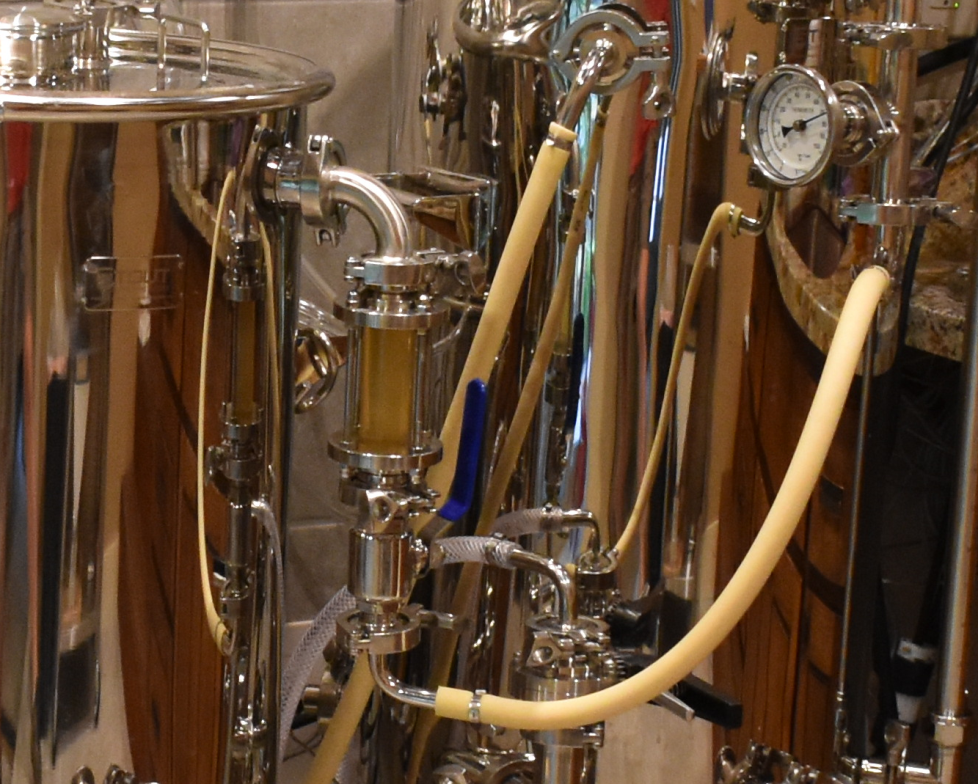
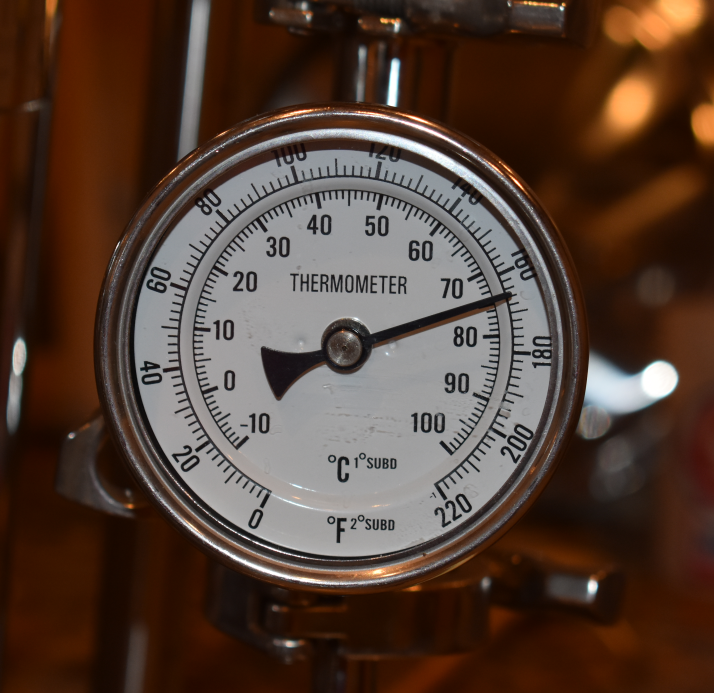
Sparge:
I sealed the brew kettle except for the 3” cap on the lid and purged with CO2 from the bottom gas inlet before starting the runoff and periodically repeated the purging using the upper gas inlet throughout the mash runoff. My two peristaltic pumps transfer wort out of the mash tun at the same rate that they add sparge water. Since the Mash Tun is closed except for the ¼” ball valve and I am keeping CO2 in the headspace, I’m not worried about the water splashing inside the mash tun. You can’t oxygenate the wort through aeration if there is no oxygen in the atmosphere. Speaking of that, on a safety note, I made sure I have plenty of fresh air coming into my brewery since I was frequently adding CO2 to the kettles. My beer doesn’t need oxygen, but I certainly do.
At kettle full, I did yet another SMB test and got another reading between 25 and 50 ppm. Still no oxygen absorbed. The brew kettle has its own sample valve, so grabbing a sample was quick and easy without having to open the kettle. I like to turn the heat up to 200 – 205°F on my brew kettle during runoff so that I don’t have to wait around for wort to start boiling when the runoff is done.
At kettle full, I set the brew kettle temperature to 215°F to get a boil going. I figure out how many gallons I need to boil off, and use that to figure out what percent of full power to set for the elements. Brag alert: All of the electric heating control panels we provide include the ability to adjust the heat of the elements. Many other systems (commercial and homebrew) cannot do this. You can download a handy spreadsheet from our website to calculate the power you need to provide to your elements to get your desired boil rate. To avoid heat stress, I set a low evaporation rate and tried to keep the total boil time under 70 minutes. By using high quality German malts, I can get away with a lower evaporation rate than normal. With a wort pH of ≥ 5.4, and using high quality German Pilsner malt, the evaporation rate can be as low as 4% to 6% per hour. Because I did not have an aggressive boil, I only removed the 3” cap and left the lid otherwise closed. At first, though, I cranked up the heat percentage to get to a boil faster. You can guess what happened next – a boil-over! Fortunately, I noticed it right away just as the foam was rising out of the 3” TC port and cut the heat. The overflow stayed right in the lid and was easy to clean up – lucky me.
I reset the heat level for the elements and restarted the boil. During this time, I cleaned out the mash tun, which was really easy. I removed the lid clamp and lid, and lifted the mash bag out and dumped the bag of grain into a wooden bucket for delivery to a nearby farm for their goats and chickens. There was minimal residue under the false bottom. And, it was a lot easier than scooping the grains out.
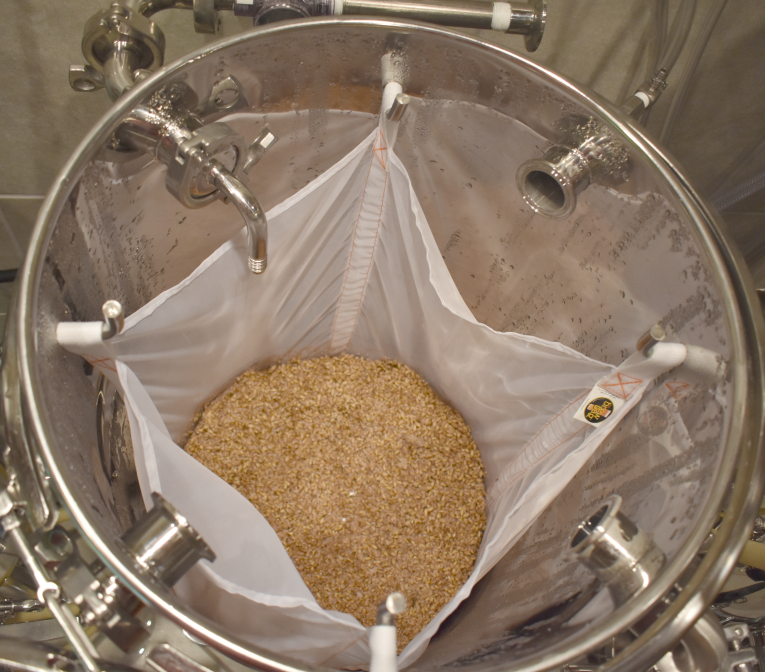

After the boil was done, I took another sulfite test and the levels were still at 25-50 ppm. Amazing – I didn’t expect that. I did my normal whirlpool routine in the brew kettle using the built-in tangential inlet, and pumped the wort into my trusty 7.3 gallon stainless steel conical fermenter. I still use the very first conical fermenter we ever produced. Another sulfite test and I got the same results. This means that I made a batch of beer and introduced practically NO measurable oxygen throughout the entire hot side process. I was really happy about that. Our products work extremely well. Maybe too well, because here is where things went a little bit sideways. Not too bad, but enough to affect the final result.
I thought I would be able to get the wort down to my pitch temperature of 42°F by chilling my tap water further by filling the hot liquor tank with ice and water and running my tap water through the HERMS coil in the hot liquor tank after passing through my all stainless steel counter-flow chiller. I hadn’t tried it before, and I paid the price for my guess. It dropped the temperature, but not nearly enough. I got my wort down into the 60’s (°F). So, I turned on the peltier coolers on the fermenter and waited an hour, but I could wait no longer. This is a delicate moment in low oxygen brewing. The yeast need some oxygen in the wort for the first phase of their growth cycle, but we don’t want too much exposure to oxygen to destroy the AAO enzyme and ruin that beautiful lingering fresh grain flavor in my Munich Helles malt. Fermentation needs to start within 6-8 hours in the fermenter in order to prevent oxidation at this stage.
I pitched my 2 liter yeast starter and then oxygenated the wort using my wand for about 60 seconds. Normally, I oxygenate for 20-30 seconds for a 5 gallon batch, but because of all the sulfites still in the wort, I decided to oxygenate longer to make sure that the sulfites didn’t steal all of the O2 from the yeast. I did another sulfite test and the measurement was still near 25 ppm. So, I oxygenated for another 60 seconds or so and tested again. The sulfite levels hadn’t noticeably dropped. I repeated this one more time, then decided enough was enough. I sealed the fermenter and let nature take its course. I concluded that the SMB and yeast would have to fight it out for all the oxygen I introduced.
At this point, I started to suspect that my sulfite test strips were defective, because they were showing so little oxygen uptake. I couldn’t believe our system worked so well keeping oxygen out. So, I took a sample of fresh water and tested that. It read 0 ppm, so I concluded the test strips were just fine. Later on, I conferred with Bryan Rabe at the low oxygen brewing website and he confirmed that he measured < 0.1ppm total O2 uptake using his Stout Tanks and Kettles’ low oxygen system. He’s got a DO meter and can check it more accurately than I can.
The bottom line is that it ended up taking almost 24 hours for the fermentation to start, which meant that the oxygen I added to the wort had ample time to do its evil work. I performed the remaining steps according to plan, but the damage was already done. The beer is actually really good, but it lacks the lingering, fresh grain flavor I covet.
So, why did I say that I didn’t add enough oxygen to my brew at the beginning of this blog? Because I added 35ppm of SMB thinking that my process would be adding oxygen that needed to be “consumed” by the sulfites. But, our low oxygen tanks did their job and the process didn’t add any measurable oxygen to the wort, which left a lot of sulfites hungry for oxygen. I tried to compensate by adding extra oxygen when I pitched, but I probably didn’t add enough satisfy the sulfites and to get the yeast going quickly enough. While the wort was in the fermenter, it had enough time to absorb enough oxygen to destroy the Ascorbic Acid Oxidase (AAO) and the lingering fresh malt flavor it provides. The better solution to this problem will be to trust our low ox equipment, and not add nearly so much SMB, if any at all. That way when I oxygenate the wort, the yeast will have enough oxygen to quickly replicate and consume the oxygen before it can destroy the fresh lingering grain flavor I am after.
So, here are my takeaways after brewing my first batch with my Stout Tanks low oxygen brewing system:
- Trust the equipment. It is designed to keep oxygen out of the entire brew process.
- Don’t add any Sodium Metabisulfite, or add very little (perhaps a few ppm only). It’s better to keep the oxygen out than it is to absorb it with SMB.
- Larger yeast starter. Use a 3 liter starter to ensure that the batch takes off faster. I realized too late that my starter wasn’t going to be big enough, and hoped for the best. Hope is not a good strategy.
Give us a call if you would like to learn more about low oxygen brewing. We would love to talk with you about how you can start your own low ox brewery.

